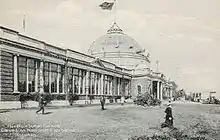| Horticulture Building | |
|---|---|
 Horticulture Building in 2005 | |
| General information | |
| Type | Exhibition building Special event space |
| Architectural style | Beaux-Arts |
| Location | Exhibition Place |
| Address | 15 Saskatchewan Road |
| Town or city | Toronto, Ontario |
| Country | Canada |
| Coordinates | 43°37′57″N 79°25′25″W / 43.6325°N 79.4236°W |
| Opened | 1907 |
| Owner | City of Toronto |
| Technical details | |
| Structural system | Steel truss |
| Floor count | 1 |
| Floor area | 32,000 square feet (3,000 m2)[1] |
| Design and construction | |
| Architect(s) | George W. Gouinlock |
| Website | |
| torontoeventcentre.com | |
The Horticulture Building, which houses the Toronto Event Centre, is a heritage building at Exhibition Place in Toronto, Ontario, Canada, containing event and conference space. It was built in 1907 for the display of horticulture during the annual Canadian National Exhibition (CNE), and it is a listed heritage building.
Along with four other buildings at Exhibition Place designed by the same architect, George W. Gouinlock, it is a National Historic Site of Canada.[2][3] In 2004, the building was leased to a private company for 20 years to use as a nightclub and for special events.
Description
The Horticulture Building was constructed in 1907 and was designed by local architect G. W. Gouinlock in the Beaux-Arts style. It is a one-storey building, in the layout of an "E", with a large glass dome at the intersection of the wings. The glass dome is the site of the main entrance facing south. The wings extend to the east and west to the north.
History
The site was previously the location of Toronto's Crystal Palace building, an exhibition hall fashioned after the design of the Crystal Palace in London, England. Toronto's Crystal Palace was destroyed by fire on October 18, 1906, spread by sparks from a fire in the grandstand building.[4] The following year, the Horticulture Building was constructed.
Between 1942 and 1946, when the CNE grounds were in use by the Canadian armed forces, the Horticulture Building became the Quartermaster Stores. In September 1949, when the S.S. Noronic passenger liner was destroyed by fire in Toronto Harbour, the Horticulture Building was turned into an emergency morgue. It temporarily housed as many as 104 casualties.[5]
In 1958, the building was used in the design competition for Toronto's City Hall. All of the models for the new city hall and square were put on display for public inspection.[6]
In 2004, Muzik Clubs Inc. won a competitive process to occupy the building and grounds from 2004 until 2024. It operated the upscale Muzik nightclub on Saturday nights and used the building for other private events. In 2013 the club proposed building swimming pools on the site in exchange for an extension of the lease until 2034. That proposal was turned down.[7] Muzik Clubs Inc. is now known as Toronto Event Centre, and its focus is more on corporate events.
Gallery
 View of the building in 1912
View of the building in 1912 Main entrance in 1912
Main entrance in 1912 The building in 1927
The building in 1927
References
- ↑ Osbaldeston, Mark (2008). Unbuilt Toronto: A History of the City That Might Have Been. p. 94.
- ↑ Gouinlock Buildings / Early Exhibition Buildings, Directory of Designations of National Historic Significance of Canada
- ↑ Gouinlock Buildings / Early Exhibition Buildings, National Register of Historic Places
- ↑ Bradburn, Jamie. "Historicist: An Exhibition in Crystal". Torontoist. Retrieved August 30, 2015.
- ↑ "Crowds Outside The Horticulture Building, 1911". CNE. Retrieved August 30, 2015.
- ↑ "Architectural models at Horticultural Building for City Hall and Square Competition, Toronto, 1958". Toronto Public Library. Retrieved August 30, 2015.
- ↑ "Exhibition Place wants to extend lease for Muzik nightclub until 2034". Toronto Star. Retrieved August 30, 2015.